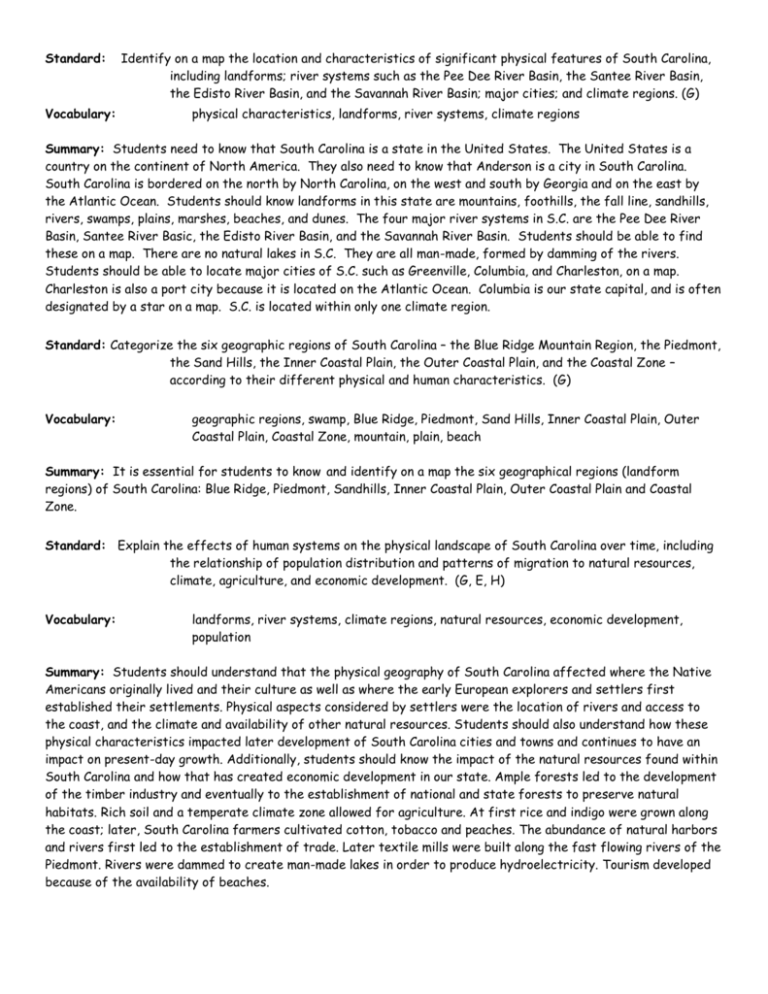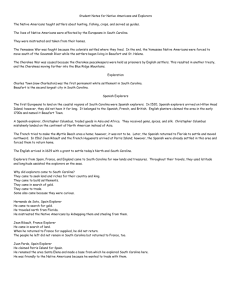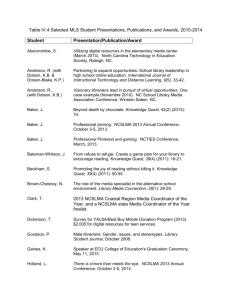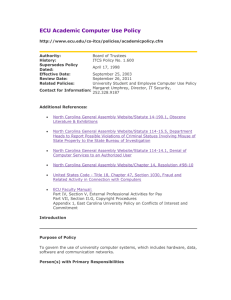Standard: Identify on a map the location and characteristics of
advertisement

Standard: Vocabulary: Identify on a map the location and characteristics of significant physical features of South Carolina, including landforms; river systems such as the Pee Dee River Basin, the Santee River Basin, the Edisto River Basin, and the Savannah River Basin; major cities; and climate regions. (G) physical characteristics, landforms, river systems, climate regions Summary: Students need to know that South Carolina is a state in the United States. The United States is a country on the continent of North America. They also need to know that Anderson is a city in South Carolina. South Carolina is bordered on the north by North Carolina, on the west and south by Georgia and on the east by the Atlantic Ocean. Students should know landforms in this state are mountains, foothills, the fall line, sandhills, rivers, swamps, plains, marshes, beaches, and dunes. The four major river systems in S.C. are the Pee Dee River Basin, Santee River Basic, the Edisto River Basin, and the Savannah River Basin. Students should be able to find these on a map. There are no natural lakes in S.C. They are all man-made, formed by damming of the rivers. Students should be able to locate major cities of S.C. such as Greenville, Columbia, and Charleston, on a map. Charleston is also a port city because it is located on the Atlantic Ocean. Columbia is our state capital, and is often designated by a star on a map. S.C. is located within only one climate region. Standard: Categorize the six geographic regions of South Carolina – the Blue Ridge Mountain Region, the Piedmont, the Sand Hills, the Inner Coastal Plain, the Outer Coastal Plain, and the Coastal Zone – according to their different physical and human characteristics. (G) Vocabulary: geographic regions, swamp, Blue Ridge, Piedmont, Sand Hills, Inner Coastal Plain, Outer Coastal Plain, Coastal Zone, mountain, plain, beach Summary: It is essential for students to know and identify on a map the six geographical regions (landform regions) of South Carolina: Blue Ridge, Piedmont, Sandhills, Inner Coastal Plain, Outer Coastal Plain and Coastal Zone. Standard: Explain the effects of human systems on the physical landscape of South Carolina over time, including the relationship of population distribution and patterns of migration to natural resources, climate, agriculture, and economic development. (G, E, H) Vocabulary: landforms, river systems, climate regions, natural resources, economic development, population Summary: Students should understand that the physical geography of South Carolina affected where the Native Americans originally lived and their culture as well as where the early European explorers and settlers first established their settlements. Physical aspects considered by settlers were the location of rivers and access to the coast, and the climate and availability of other natural resources. Students should also understand how these physical characteristics impacted later development of South Carolina cities and towns and continues to have an impact on present-day growth. Additionally, students should know the impact of the natural resources found within South Carolina and how that has created economic development in our state. Ample forests led to the development of the timber industry and eventually to the establishment of national and state forests to preserve natural habitats. Rich soil and a temperate climate zone allowed for agriculture. At first rice and indigo were grown along the coast; later, South Carolina farmers cultivated cotton, tobacco and peaches. The abundance of natural harbors and rivers first led to the establishment of trade. Later textile mills were built along the fast flowing rivers of the Piedmont. Rivers were dammed to create man-made lakes in order to produce hydroelectricity. Tourism developed because of the availability of beaches. Standard: Compare the culture, governance, and geographic location of different Native American nations in South Carolina, including the three principal nations – Cherokee, Catawba, and Yemassee – that influenced the development of colonial South Carolina. (H, G, P, E) Vocabulary: Native Americans, culture, customs, tribe, folklore, legends, contributions, governance, location, nation, Cherokee, Catawba, Yemassee Summary: The Native American tribes of the Eastern Woodland region who lived in South Carolina were different from one another in language. However their cultures and government were similar. Culture depended on the geographic area in which they lived. Cherokee culture involved living off the mountainous land of the Blue Ridge Mountain region and the hilly western Piedmont. The Cherokee settled near rivers and the Cherokee nation was comprised of many villages that were loosely united with each other. Cherokee traveled from village to village in large dugout canoes. They were hunters/gatherers, fishermen and farmers. They lived in longhouses during the summer and wattle and daub houses in the winter. The Cherokee were powerful and thought of themselves as “the real people.” Their villages were run by councils where different leaders made decisions affecting the people. The leaders were elected and the Cherokee had a form of a constitution. Cherokee women sat on the village councils and had a significant voice in whether or not the tribe went to war. The Cherokee were traders and had a well traveled trail that ran from the mountains to the Atlantic Ocean. The Catawba lived off the land of the Piedmont. They were also hunters and farmers. The Catawba traveled the rivers in dugout canoes and were known as “River People.” They were powerful in their part of the state, near where Rock Hill is today. The Catawba lived in wigwams and were also governed by councils. The Catawba were famous for their pottery and were more peaceful than many Native Americans of that time in South Carolina. The Yemassee lived in the coastal zone on the southern coast of South Carolina, near the Georgia border. They lived in wigwams close to the coast in the summer and farther inland in wattle and daub houses along rivers during the winter. The Yemassee hunted, fished, farmed, and gathered clams and oysters. Standard: Summarize the impact that the European colonization of South Carolina had on Native Americans, including conflicts between settlers and Native Americans. (H, G) Vocabulary: Europeans, Native Americans, conflicts, settlers, colonization Summary: Most of the Native Americans were friendly to the Europeans at first, enjoying the trading relationship. Europeans traded with the Native Americans for furs in exchange for knives, guns and other manufactured goods. Trade relations between the two groups worsened when they were handled unfairly by the Europeans. In addition, as settlers moved west from the lowcountry to the back country they encountered more Native American tribes who, at first, moved farther west themselves. As Europeans continued to encroach on the territories or hunting grounds of the Native Americans around them, conflict arose over the ideas of land ownership and land use. Native Americans believed in communal ownership of the land and believed it could not be owned while Europeans believed individual ownership of the land and claimed it for themselves. The settling of the town of Beaufort was the last straw for the Yemassee nation of the southern coast. The Yemassee fought back and for a year there was much violence and bloodshed between the native nations and the European settlers of South Carolina. However, not all native tribes resisted the Europeans. The Cherokee sided with the English against the Yemassee and their allies. The Yemassee War ended in a truce with both sides badly wounded by the year of hardship. The Yemassee were eventually driven out of the state. Disease also killed large numbers of the Native Americans in South Carolina after the arrival of the Europeans because the natives had no immunity to European diseases. Standard: Explain the motives behind the exploration of South Carolina by the English, the Spanish, and the French, including the idea of “for king and country”. (G, P, E, H) Vocabulary: explorers, motive, English, Spanish, French Summary: European explorers wanted to find a shorter route to the spices of Asia and to find gold, silver, precious metals or other valuables such as furs. The Spanish, French and English monarchs were also interested in expanding their empires by acquiring new land. Monarchs promoted exploration and settlement so that their country could be richer and more powerful than their European rivals. Explorers were sent out to claim new lands for “king and country.” Merchants and missionaries wanted to expand their knowledge of the world and to spread Christianity. Students need to know the geographic location of England, Spain, and France in relation to the New World. Standard: Summarize the activities and accomplishments of key explorers of South Carolina, including Hernando de Soto, Juan Pardo, Jean Ribault, Henry Woodward, and William Hilton. (H, G) Vocabulary: accomplishments, Hernando de Soto, Jean Ribault, Henry Woodward, William Hilton Summary: Several explorers traveled through or established temporary settlements in South Carolina because of the national rivalry over land claims in the New World. Hernando de Soto explored for Spain in search of gold and slaves. He and his men traveled north from Spanish Florida, and encountered Native Americans in South Carolina. However, he did not establish a permanent settlement in South Carolina. Instead De Soto traveled extensively throughout the Southeastern United States in search of riches. Jean Ribault, exploring for France, came to South Carolina to compete with the Spanish for land in the New World. After arriving in Port Royal Harbor, which he named, he and his men built a fort. Located on present day Parris Island, Charlesfort provided protection to the colonists that Ribault left behind. Eventually the settlement at Charlesfort failed and the surviving colonists returned to France. The French never again attempted to settle in South Carolina. Juan Pardo, exploring for Spain, arrived at Parris Island and claimed the land for Spain. He re-named the land Santa Elena and used it as a base from which he explored the interior of South Carolina. Juan Pardo tried to make friends with the Native Americans because the Spanish were beginning to see how trade with the Native Americans could be beneficial. Henry Woodward arrived on the English ship Carolina which landed at Bull’s Bay. Woodward’s group established the first English settlement in South Carolina on the Ashley River and named it Charles Fort. Woodward traveled and explored the interior of South Carolina for England. Woodward traded with the Native Americans and tried to pave the way to honest, friendly relations with them. William Hilton was also from England. Hilton was hired by English settlers in Barbados to explore the coast of present day South Carolina to find more lush land for plantations. He claimed the area now known as Hilton Head for England. Later English migrants from Barbados became an important part of the English colony of South Carolina Standard: Summarize the contributions of settlers in South Carolina under the Lords Proprietors and the Royal colonial government, including the English from Barbados and the other groups who made up the diverse European population of early South Carolina. (H, G) Vocabulary: Lords Proprietors, Barbados, contribution, Royal Colonial Government Summary: The English were the first to establish a permanent colony in the area. The king of England gave the land to eight Lords Proprietors in payment of a debt. One of these proprietors was Lord Anthony Ashley Cooper for whom the rivers near Charleston are named. The Lords Proprietors commissioned the writing of the Fundamental Constitutions of Carolina which established representative government and guaranteed religious freedom in the colony and thus transferred the traditions of democratic government from England to South Carolina. The Lords Proprietors attracted new settlers to the colony by offering them free land. Many of the Englishmen who settled Charles Town came from the British settlement in Barbados where the plantation system had already been well established. These Englishmen brought the institution of slavery with them. Their rice and indigo plantations, run with African slave labor, made South Carolina one of the richest of the 13 English colonies. The Huguenots were French Protestants who were persecuted in Catholic France. They came to South Carolina for religious freedom. The Huguenots started the South Carolina Society which started schools and helped the poor. European Jews were also attracted to the colony because of its religious toleration. They established a synagogue in Charleston and contributed to the city’s economic growth. The German and Scotch-Irish people settled the backcountry, which became the breadbasket of the colony. These rugged individualists were hardworking farmers but were sometimes scorned by the elite of the coast. After the Proprietors could not or did not provide enough protection for the backcountry settlers against the Native Americans, the colonists asked the King to take over control of the colony. He did so and sent a Royal Governor to govern the colony.









